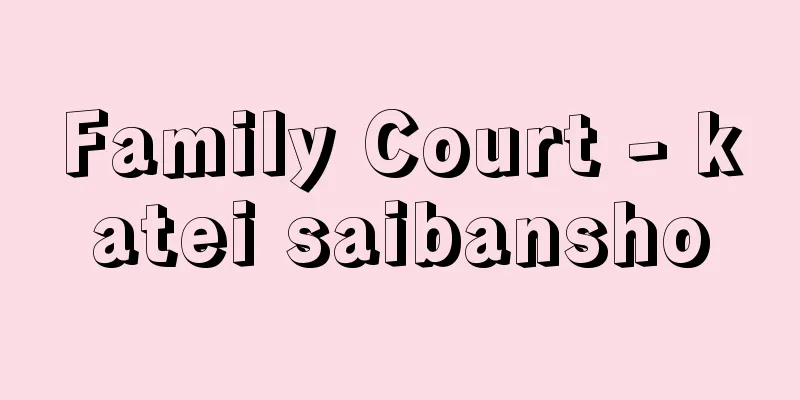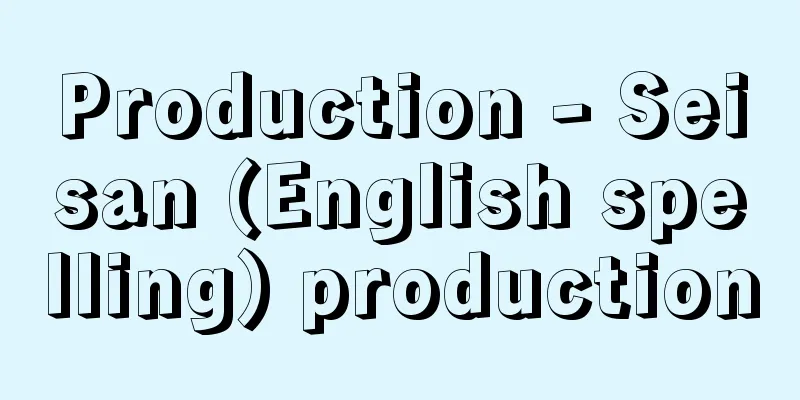Family Court - katei saibansho

|
A lower court that mainly handles adjudication and mediation of family law cases and juvenile protection cases. Its location and jurisdiction are the same as those of district courts, and there are 50 of them nationwide. The Supreme Court can set up branches or sub-offices to handle some of the affairs of the family courts. Family courts were not recognized from the beginning of the Court Act, but were established in 1949 (Showa 24) by an amendment made by Act No. 260 of 1948 with the aim of establishing an independent court that would combine the powers of the Domestic Relations Courts (established in 1948), which were branches of District Courts, and the Juvenile Courts (organizations that impose protective measures for juvenile crimes; established in 1923), which were under the jurisdiction of the Ministry of Justice. [Toshiaki Ito, May 19, 2016] Powers of the Family CourtThe Family Court has the following powers: (1) Adjudication and mediation of family matters as provided for in the Domestic Relations Proceedings Act. (2) The first instance trial of personal status lawsuits as stipulated in the Personal Status Litigation Act. Initially, district courts had jurisdiction over personal status lawsuits as the first instance court, but the Personal Status Litigation Act enacted in 2003 transferred jurisdiction over personal status lawsuits from district courts to family courts, as it deemed it appropriate for family courts, which have their own investigative body called family court investigators with various specialized knowledge and which conduct family mediation, to be in charge of personal status lawsuits. (3) Trial of juvenile protection cases as stipulated in the Juvenile Law. (4) Other matters that are given the authority of the family court under other laws, such as cases related to family registers under the Family Registration Act (such as changing a name or gender), approval of entrustment to foster parents under the Child Welfare Act, and permission to place a protected person in a foster home under the Public Assistance Act. In addition to these, the court also provides family counseling services in addition to the powers prescribed by law, and in addition to its judicial functions, it also carries out the function of adjusting family environments (case work) through family court investigators. [Toshiaki Ito, May 19, 2016] OrganizationFamily courts are composed of a considerable number of judges (judges and assistant judges) (the number of judges in each family court is determined by the Supreme Court). Among these, judges handling domestic relations cases were called "family relations judges" under the old Domestic Relations Adjudication Act, but under the current Domestic Relations Procedure Act, the term "family relations judges" was abolished for reasons such as the incongruity of domestic relations judges also being involved in domestic relations mediation. Family courts have secretariat offices and, in addition to judges, staff such as court clerks, court stenographers, assistant court stenographers, court administrative officers, and court technicians are also assigned, as well as family court research officers and assistant research officers who are unique to family courts. In addition, although not full-time staff, there are also family court participants for family court adjudications and family court mediators for family mediation, who are selected from the private sector. [Toshiaki Ito, May 19, 2016] Family Court InvestigatorFamily court investigators are assigned to each family court and perform the necessary investigations for adjudication and mediation of family cases, as well as other duties prescribed by law. In adjudication and mediation of family cases and juvenile protection cases, the maintenance of a peaceful and healthy family and the upbringing of healthy juveniles are required, so a thorough investigation of the facts, including the social and living environment surrounding the people involved, is required. The investigation also requires the use of specialized knowledge in medicine, psychology, sociology, economics, and other fields to investigate the personalities, careers, living conditions, financial status, and family and other environments of the people involved in the case. In addition to conducting these investigations, family court investigators also perform duties such as contacting child welfare institutions, discovering juveniles who should be referred to juvenile adjudication and reporting them to the court, and guarding and observing juveniles for adjudication and protective measures, when deemed necessary for the purpose of adjusting the family environment. In performing these duties, they follow the orders of the judge in charge of the case. [Toshiaki Ito, May 19, 2016] Judicial institutionsWhen a family court conducts a hearing or trial, a single judge handles the case (sole judge system), but when other laws stipulate that a collegial body should handle the case (for example, trials regarding the disqualification or recusal of a family court judge), a collegial body is used. The number of collegial members is three, one of whom is the presiding judge, just like in district courts. [Toshiaki Ito, May 19, 2016] [References] | | | | | | | |Source: Shogakukan Encyclopedia Nipponica About Encyclopedia Nipponica Information | Legend |
|
おもに、家事事件の審判・調停および少年保護事件の審判を行う下級裁判所。その所在地や管轄地域は、地方裁判所と同様で、全国に50か所設けられている。最高裁判所は、家庭裁判所の事務の一部を取り扱わせるため、支部または出張所を設けることができる。 家庭裁判所は、裁判所法の制定当初から認められていたものではなく、1949年(昭和24)に、昭和23年法律第260号による改正によって、それまで、地方裁判所の支部であった家事審判所(1948年設置)と法務省の所管であった少年審判所(少年犯罪について保護処分を行う機関。1923年設置)の権限をあわせて行う独立の裁判所を設ける趣旨から設置されたものである。 [伊東俊明 2016年5月19日] 家庭裁判所の権限家庭裁判所は、次のような権限を有する。 (1)家事事件手続法で定める家事事件の審判および調停。 (2)人事訴訟法で定める人事訴訟の第一審の裁判。当初は、地方裁判所が人事訴訟についても第一審裁判所として管轄権を有していたが、種々の専門的知見を有する家庭裁判所調査官という独自の調査機関を備え、家事調停を実施している家庭裁判所が人事訴訟について担当するのが適切であるとして、2003年(平成15)制定の人事訴訟法によって、人事訴訟の管轄が地方裁判所から家庭裁判所に移管された。 (3)少年法で定める少年の保護事件の審判。 (4)そのほか、他の法律で家庭裁判所の権限とされたもの。たとえば、戸籍法に基づく戸籍に関する事件(氏名や性別の変更など)、児童福祉法に基づく里親に委託することの承認、生活保護法に基づく被保護者を養護施設に収容するについての許可などである。 これら以外に、法律で定められた権限以外のものとして、家事相談を行っており、さらに、司法的機能のほかに、家庭裁判所調査官による家庭環境調整(ケース・ワーク)機能も担っている。 [伊東俊明 2016年5月19日] 組織家庭裁判所は相当な員数の裁判官(判事および判事補)で構成される(各家庭裁判所の裁判官の員数は、最高裁判所が定める)。このうち、家事事件を扱う裁判官は、旧家事審判法のもとでは、家事審判官とよばれていたが、家事審判官が家事調停にも携わることについての違和感を払拭することができないなどという理由により、現行の家事事件手続法のもとでは、家事審判官という呼称は廃止された。 家庭裁判所には事務局が付置され、裁判官以外の職員として、裁判所書記官、裁判所速記官、裁判所速記官補、裁判所事務官、裁判所技官などが配置されるほか、家庭裁判所に特有の職員として、家庭裁判所調査官および調査官補が置かれている。なお、常勤の職員ではないが、民間から選任される家事審判の参与員と家事調停の家事調停委員がいる。 [伊東俊明 2016年5月19日] 家庭裁判所調査官家庭裁判所調査官は各家庭裁判所に置かれ、家事事件の審判および調停に必要な調査その他、法律において定められている事務を行う。家事事件の審判・調停および少年保護事件においては、平和で健康な家庭の保持、健全な少年の育成が要求されるため、関係人を取り巻く社会生活環境を含めた事実関係の十分な調査が要請される。その調査も、事件の関係人の性格・経歴・生活状況・財産状態および家庭その他の環境について、医学・心理学・社会学・経済学その他の専門的知見を活用した調査が要求される。家庭裁判所調査官は、これらの調査を行うとともに、家庭環境調整のために必要と認めるときは、児童福祉機関と連絡をとり、少年審判に付すべき少年を発見して裁判所に報告し、審判や保護処分のために、少年を観護・観察するなどの職務を行う。これらの職務を行うにあたっては、その事件を担当する裁判官の命令に従う。 [伊東俊明 2016年5月19日] 裁判機関家庭裁判所が審判または裁判を行うときは、1人の裁判官がその事件を取り扱うが(単独制)、他の法律において、合議体で取り扱うべきものと定めているときは(たとえば、家庭裁判所の裁判官の除斥、忌避に関する裁判など)、合議体による。合議体の員数は3人であり、そのうち1人を裁判長とする点は、地方裁判所と同様である。 [伊東俊明 2016年5月19日] [参照項目] | | | | | | | |出典 小学館 日本大百科全書(ニッポニカ)日本大百科全書(ニッポニカ)について 情報 | 凡例 |
>>: Private tutor - KATEIKYOSHI
Recommend
Footwork - Footwork
〘 noun 〙① A general term for techniques used in ju...
Administrative Order - Gyoseirei
...The laws of the absolute monarchy are full of ...
Komura Jutaro
Year of death: November 26, 1911 (Meiji 44) Year o...
ethyl
CH 3 CH 2 -. The name of the alkyl group formed w...
Oguri Fuyou
Novelist. Born in Aichi Prefecture. Real name Kat...
Obasanjo, O. (English spelling) ObasanjoO
...Muhammad had great public support, but in Febr...
Crossandra nilotica (English spelling) Crossandra nilotica
…[Ichiro Sakanashi]. … *Some of the terminology t...
Floating seaweed
This refers to seaweed that drifts on the ocean&#...
Pachydrilus nipponicus (English spelling) Pachydrilus nipponicus
...It is used as fishing bait. One earthworm that...
Minamishima [town] - Nanto
An old town in Watarai County in the central south...
Orange Order; Loyal Orange Association
An organization of Protestants in Northern Ireland...
Almanaque Nautico (English)
...Used for various astronomical observations, as...
Nyosen - Nyosen
1644-1715 (Shoho 1-Shotoku 5) A haiku poet from th...
Singapore - Singaporu (English spelling)
A country in southern Southeast Asia, consisting ...
Four Seats of Color - Shiza no Zoushiki
During the Edo period, town officials under the Ky...









